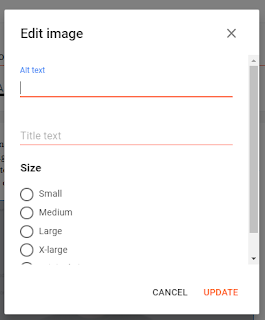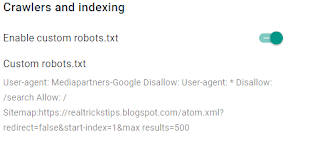Advanced Seo tips in 2021 for the blogger to rank your blog on Google
1. Optimization of URL
Blog post URLs play an important role in increasing search engine rankings for your post pages and increasing click-through rate (using CTR).
Although a URL or web address may not receive the most attention from visitors, it is still receiving attention from search engines.
Posting a permalink to Blogger is another great way to expand your blog posts with search engines, especially those like Bing, Yahoo, and Baidu.
2. Custom Blogger URL:
Here's how to add a custom search engine and friendly URL to people in your blog post.
When you edit your draft posts or create new posts, click on the "Permalinks" tab under "Post Settings."
Blogger will generate a permalink to post your blog automatically. But you can rename it as you would like. Click on "Custom Permalink" and enter your custom URL text as the screenshot below.
3. Tips for creating a complete permalink:
- Customizing a permalink is an SEO Blogger setting. Here are a few tips to perfect your post URLs.
- Use keywords inside your blog post permalink. Enter a keyword at the beginning of the permalink post.
- Create a descriptive submission permalink instead of just adding keywords.
- Try installing a shorter permalink.
- If your post is a list item, avoid using numbers in the permalink.
The blog post permalink is one of the top things on your blog that can increase SERP levels with certain keywords. When drawing a permalink, be sure to follow the simple tips above to create a useful blog post URL.
4. Use of Images:
Although search engines have become extremely clever, they have never been so smart yet. How do search engines find information about images, videos, infographics, and Slideshares?Search engine bots like Googlebot, Bingbot, and Baiduspider use metadata, organized schema.org data, and relevant HTML tags to get more information about any visual content.
In images, there is one attribute for search engines and one human factor. That's right; ALT: other text (search engines) Title: title tag (of people)
5. Use of Meta Tags:
Now we dive deeper into Blogger SEO. At Blogger, we do not have plugins like Yoast SEO. So, everything goes to coding. Here is the Meta code of the blogger's description and keywords.Step #2: Now search the following code in your Blog Template. <b:include data=’blog’ name=’all-head-content’/> If you can’t find the below code, find below HTML tag.
<head>
<b:if cond=’data:blog.url == "https://www.pitiya.com/"’><meta content=’Your Blog Meta Description Here… No more than 160 words…‘ name=’description’/><meta content=’A few primary keywords separated by commas‘ name=’keywords’/></b:if>
6. Heading tags for SEO:
Search engine optimization is not difficult if you understand the basic concept of quality and a well-coded webpage. Google uses other features, such as title tags, to obtain more important information about its index. So you need to understand how to use SEO title tags. What are Title Tags? For web design, title tags show the categories and sections of a web document. So screen users can easily scan your webpage.
There are 6 title tags. <h1>, <h2>, <h3>, <h4>, <h5>, <h6>
The H1 title tag is the most important title tag. You can use the <h1> tag in a blog post title.
Ex: <h1> Shipping Title </h1>
On search engine results pages, your title tag will serve as the post title.
Eg: Post title - Blog Name
Do not overuse the <h1> tag more than once. Because there could not be two topics in one web document.
The second most important tag for an SEO topic is <h2>. Use this tag to split parts of your document. Search engines use the H2 tag to identify important information. You can use more than one H2 marker on a web page as soon as it provides the number of screen readers.
The third most important H factor is the H3 marker. This tag is used to display sub-sections of a web page. You can use any number of H3 tags under each H2 item.
7. Breadcrumbs:
Google checks many items in the SERP. Occasionally, they add the author's images to search results. Breadcrumbs are one of the new tests of Google. ECommerce websites make the most use of bread crumbs.Breadcrumbs have several search engines and user-specific benefits of the site:
They highlight keywords in search engines that they should notice in your navigation
They all add content consistency to your web pages
They give SEO emphasis to a page that highlights a particular anchor text that links to internal pages or section pages. That increases the CTR of your web page.
Breadcrumbs encourage visitors to click on links. So your website gets a higher CTR.
They provide a visual guide to what they might want.
They can add more internal links to search results to provide easy ways to navigate the site internally.
It increases the user's intent as the loaves of bread in Google search results mean that the site has authority over other people.
To show BreadCrumbs in Google search results, your blog template should be customized for Breadcrumbs. To learn more about BreadCrumbs, read this Google guide here.
SEO for Blogger Breadcrumbs:
Use labels for all posts. Breadcrumbs on Google will prioritize the main first label.
Use appropriate labels related to the post title.
Make sure your theme is well-structured so that search engine bots can identify the labels.
8. Blogger Custom Robot Header tags:
The developers of Blogger have introduced Custom Robots Header tags to control the search results of Blogger pages such as the homepage, Post pages, Static pages, search pages, and Archive pages.
You can use Blogger's custom robots tags to protect other web pages that show up in search results pages. For example, you do not want to show search results pages and archive pages in the Google SERP. So you want to identify those web pages. An easy way to enable custom robotic header tags and pinpoint those inactive web pages.
Here's how to enable custom header tags.

9. How to use custom robots head tags on Blogger
Step # 1: Sign in to your Blogger account
Step # 2: Navigate to Settings >> Search Favorites
Step # 3: Click on the "edit" link under the Custom Robots Header Tags section to enable robotic head tags on Blogger.
Once you click the 'Edit' link, you will be asked to enable custom robots tags. Select the "Yes" option. Adjust the top tag settings as the screenshot below.
Now click on the “Save Changes” button.
10. Blogger Custom Robots.txt:
Blogger Custom Robots.txt is another important SEO tool built within Blogger. Remember that everything you do in this phase should be done with your utmost care. One minor error can prevent your blog pages from appearing in search results.
What is Robots.txt?
Robots.txt is a text file hosted on Blogger servers (where your blog is hosted) showing bots in the search engine what to follow and crawl. We used Blogger Custom Header tags to protect the unique blog posts in search engines. But we can use the Blogger Robots.txt file to protect individual web pages and perform advanced SEO tasks.When a web spider starts following links to your blog, for the first time, it reads a Robots.txt file. Then follow its rules and crawl your web pages.
Here’s a sample code of Robots.txt
User-agent: Mediapartners-Google
Disallow:
User-agent: *
Disallow: /search
Allow: /
Sitemap: https://example.blogspot.com/sitemap.xml
or
User-agent: Mediapartners-Google
Disallow:
User-agent: *
Disallow: /search
Allow: /
Sitemap:https://example.blogspot.com/atom.xml?redirect=false&start-index=1&max results=50011. SSL
Google has made it clear that it prioritizes SSL-encrypted websites when measuring Google SERP (Search Engine Result Page) standards.
That basically means that blogs not written with SSL will not be ranked high in the Google SERPs.
The good news is that you can enable SSL on your Blogger blog for free!














Very nice blog .Thanks for sharing good informative content for SEO.
ReplyDeleteDigital marketing company in Kochi
SEO Company in Kerala
Hey I am Moumita from Kolkata. I am Digital Marketing Executive at SEO Villas Private Limited & I will learn a lot of new stuff right from this article. Hope more to come.
ReplyDelete